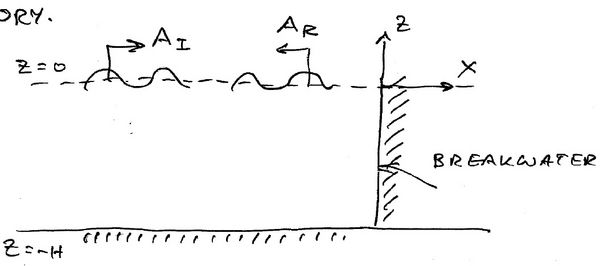Difference between revisions of "Waves reflecting off a vertical wall"
From WikiWaves
Jump to navigationJump to search (Created page with 'thumb|right|600px|Breakwater Waves reflecting off a vertical wall is one of the few very important analytical solutions of regular waves interacting with…') |
|||
| Line 4: | Line 4: | ||
<center><math> \zeta_I = \mathrm{Re} \left \{ A_I e^{-\mathrm{i} k x+\mathrm{i}\omega t} \right \} </math></center> | <center><math> \zeta_I = \mathrm{Re} \left \{ A_I e^{-\mathrm{i} k x+\mathrm{i}\omega t} \right \} </math></center> | ||
and the reflected is | and the reflected is | ||
| − | <center><math> \zeta_R = \mathrm{Re} \left \{ A_R e^{ | + | <center><math> \zeta_R = \mathrm{Re} \left \{ A_R e^{\mathrm{i}k x+\mathrm{i}\omega t} \right \} </math></center> |
| − | where the sign of the <math> e^{ | + | where the sign of the <math> e^{\mathrm{i} k x}\, </math> term has been reversed to denote a wave propagating to the left. <math> A_R\,</math> can be complex in order to allow for phase differences. |
The corresponding velocity potentials are | The corresponding velocity potentials are | ||
<center><math> \Phi_I = \mathrm{Re} \left \{ \frac{\mathrm{i} gA_I}{\omega} \frac{\cosh k k h (z+h)}{\cosh k h} | <center><math> \Phi_I = \mathrm{Re} \left \{ \frac{\mathrm{i} gA_I}{\omega} \frac{\cosh k k h (z+h)}{\cosh k h} | ||
| − | e^{-\mathrm{i}+i\omega t} \right \} </math></center> | + | e^{-\mathrm{i} k x + \mathrm{i}\omega t} \right \} </math></center> |
<center><math> \Phi_R = \mathrm{Re} \left \{ \frac{\mathrm{i} gA_R}{\omega} \frac{\cosh k (z+h)}{\cosh k h} | <center><math> \Phi_R = \mathrm{Re} \left \{ \frac{\mathrm{i} gA_R}{\omega} \frac{\cosh k (z+h)}{\cosh k h} | ||
e^{\mathrm{i} k x +\mathrm{i}\omega t} \right \} </math></center> | e^{\mathrm{i} k x +\mathrm{i}\omega t} \right \} </math></center> | ||
| Line 27: | Line 27: | ||
[[Category:Linear Water-Wave Theory]] | [[Category:Linear Water-Wave Theory]] | ||
| + | [[Category:Complete Pages]] | ||
Revision as of 21:37, 3 April 2010
Waves reflecting off a vertical wall is one of the few very important analytical solutions of regular waves interacting with solid boundaries seen in practice. The other is wavemaker theory. Let the incident wave elevation be
and the reflected is
where the sign of the [math]\displaystyle{ e^{\mathrm{i} k x}\, }[/math] term has been reversed to denote a wave propagating to the left. [math]\displaystyle{ A_R\, }[/math] can be complex in order to allow for phase differences.
The corresponding velocity potentials are
On [math]\displaystyle{ x = 0 \, }[/math]:
or
The resulting total velocity potential is
The resulting standing-wave elevation is:
